Since the 1980s, Iran has forged a network of political alliances across the Middle East that now give it more influence than its Gulf rivals and the United States. Tehran has exploited local grievances, sectarian identity, and conflicts to create or foster political parties, most visibly in Lebanon, Iraq and the Palestinian Territories but also smaller underground movements in Bahrain and Kuwait.
Most of Iran’s political allies originated as armed cells or groups that later birthed political wings that became equally or more important in the local landscape. The parties share Iran’s regional goals to disparate degrees, but they provide Iran potentially even greater influence than its local militia allies. Iran’s political allies have in turned shielded allied militias from bids to disarm them. The two-pronged strategy has helped Iran gain political footholds in Arab-majority countries while simultaneously advancing its regional security interests.
In early 2020, the impact of Iran’s roster was reflected in diverse ways that furthered its agenda—and undermined the influence of the United States and its regional allies:
- On January 5, Iraq’s parliament voted 170 to 0 to expel U.S. forces. All of Iran’s Shiite allies in parliament voted for the non-binding resolution. Nearly 150 Sunni and Kurdish lawmakers did not show up to vote, some possibly due to intimidation by pro-Iran militias. The move signaled Iran’s growing political weight in a country where the U.S. has invested two trillion dollars, thousands of lost lives and years of military and political engagement.
- On January 21, Lebanon announced the formation of a new government that strengthened Iran’s hand in Lebanon. It was the first government to be exclusively backed by Hezbollah and its allies. The 20-person cabinet included two ministers backed by Hezbollah. Prime Minister Hassan Diab, President Michel Aoun, and Parliamentary Speaker Nabih Berri are also longstanding allies of Hezbollah.
- On January 6, Hamas leader Ismail Haniyeh spoke at the funeral of Qassem Soleimani. He eulogized the Qods Force commander as the “martyr of Jerusalem” and praised “Supreme Leader Ayatollah Ali Khamenei and the Iranian nation” for its fight against Israel. Haniyeh reportedly chose to defy explicit warnings by both Egypt and Saudi Arabia, two key U.S. allies in the region, not to travel to Iran. His visit scuttled diplomatic efforts to reconcile Hamas and Saudi Arabia ahead of the release of the White House’s Middle East Peace Plan.
Lebanon
Hezbollah
Founded: 1982
Leaders:
• Secretary General Hassan Nasrallah
• Deputy Secretary General Naim Qassem
Parliament (2020): 13 seats out of 128
Other government positions (2020): Allies hold the presidency, premiership, parliamentary speakership, and two cabinet positions.
Evolution: Iran’s Revolutionary Guards fostered the creation of Hezbollah within weeks of Israel’s 1982 invasion of Lebanon. Tehran exploited both local Shiite grievances against Sunni and Christian politicians as well as Israel’s harsh treatment of Shiites in southern Lebanon. For a decade, Hezbollah mobilized an underground militia and honed its military skills in attacks against Israel and Western forces—including the U.S.-led Multinational peacekeepers — deployed in Lebanon. Suicide attacks on two U.S. embassies, in 1983 and 1984, and on Marine peacekeepers, in 1983, led the United States to withdraw the Marines, end its peacekeeping mission, and retreat diplomatically.
In 1992, Hezbollah emerged from the underground to form a political party and run in the first parliamentary elections since the 15-year civil war ended. It won eight seats, the most of any party. (In Lebanon, 10 of the 18 recognized religious sects are allocated a specific number of seats in parliament). Hezbollah then allied with four independent lawmakers to form the largest bloc. Iran’s influence in the government of a country—through a powerful local party—gave it important access far from its own borders and all the way to the Mediterranean.
After the 2005 Cedar Revolution, Hezbollah became the dominant party—and glue—of the March 8 bloc that grew to include Amal, another Shiite Party, the Free Patriotic Movement, the largest Christian party, and smaller Christian, Sunni, and Druze parties and independents. In 2016, Michel Aoun, founder of Free Patriotic Movement and a Hezbollah ally, became president, partly because of Hezbollah’s lobbying.
In 2018, Iran’s Shiite, Christian, Druze and independent allies in the March 8 bloc won 70 out of parliament’s 128 seats in parliament. After Prime Minister Saad Hariri resigned in December 2019, Hezbollah and its allies, including President Aoun, selected Hassan Diab as prime minister. In January 2020, Diab formed the first government to be exclusively backed by Hezbollah’s parliamentary coalition—in turn increasing Iran’s influence too.
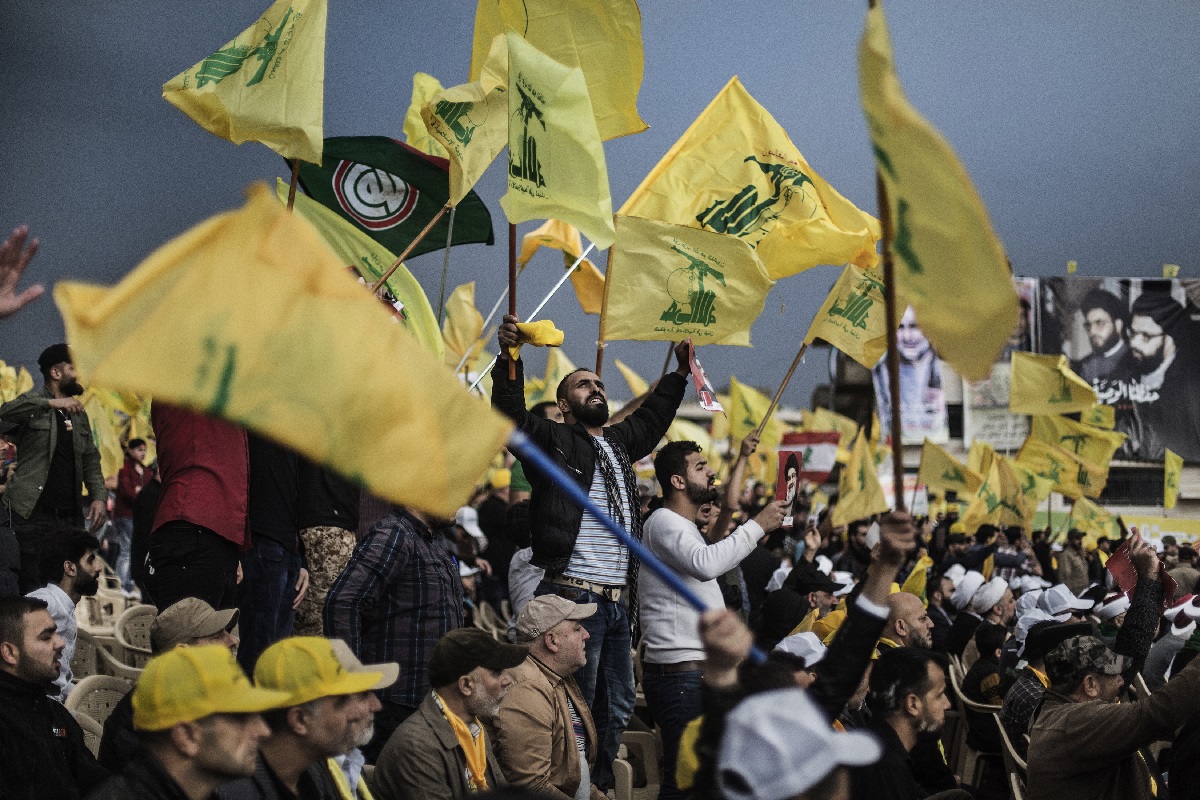
Hezbollah supporters at a rally ahead of the 2018 parliamentary elections (Diego Ibarra Sanchez/The New York Times)
Iran’s interests in Lebanon—and along the Israeli border—have been protected because Hezbollah’s political leverage ensures it can resist pressure from the government, the Lebanese Armed Forces and foreign powers to surrender its weaponry. Government statements in 2009 and 2019 implicitly justified Hezbollah’s right to keep its militia and its arms. The 2019 statement said that Lebanese citizens have the right to “resist Israeli occupation and repel its aggression,” although it did not name Hezbollah directly.
Ties with Iran: Hezbollah’s first manifesto, issued in 1985, mirrored Iran’s revolutionary ideology, including its opposition to the West and Israel, as well as loyalty to Iran’s supreme leader. Iran’s influence has also been apparent in the organization’s logo, which includes a bare hand holding up a rifle and a globe, similar to the IRGC’s logo.
In the past, Iran has provided up to $700 million a year in financial aid, although support was curtailed after U.S. sanctions were reimposed in 2018, according to the Trump administration. Iran has also provided military training and weapons, including 130,000 to 150,000 rockets and missiles, one of the largest arsenals in the region.
Iranian leaders have developed strong relationships with Hezbollah leaders, reflected in frequent meetings both in Beirut and Tehran. In recent years, Foreign Minister Mohammad Javad Zarif and Parliamentary Speaker Ali Larijani visited Beirut to confer with Nasrallah on local and regional developments. Former Qods Force commander General Qassem Soleimani was a close confidant of Nasrallah. Hezbollah leaders have also been warmly received in Tehran. In 2000, Supreme Leader Ayatollah Ali Khamenei hosted Nasrallah in Tehran to congratulate him for Hezbollah’s role in pushing Israel to withdraw from Lebanon.

Supreme Leader Ayatollah Ali Khamenei, Hassan Nasrallah and Qods Force Commander Qassem Soleimani in a photo thought to have been taken in 2019 in Tehran
Iraq
Shortly after its 1979 revolution, Iran fostered many of Iraq’s Shiite groups during the rule of Saddam Hussein. Most started as militias and evolved over time into political parties. By 2017, Iraq had at least ten parties with ties to Iran. In 2018, eight pro-Iran groups merged into the larger Fatah alliance. Other parties with historic ties to Iran remained separate from Fatah but joined together to prop up a government friendly to Tehran government in Baghdad.
Fatah Alliance
Founded: 2018
Leaders:
• Secretary General of Badr Organization Hadi al Ameri
• Secretary General of Asaib Ahl al Haq Qais al Khazali
Parliament (2018): 47 seats of 329, making it the largest pro-Iran bloc.
Other government positions (in 2020): The prime minister is backed by Fatah.
Evolution: The eight groups in the Fatah Alliance consisted of older parties dating to the 1980s as well as new groups formed in 2014. They had disparate levels of political organization but shared common ties with Iran. All have received funding from Iran; all of their armed wings have received arms and training from Iran or Lebanese Hezbollah. In 2018, they each won at least one seat in parliament. These groups included:
- The Badr Organization: In 1982, the Badr Brigade, Iran’s oldest proxy in Iraq, was formed by exiles in Iran and initially funded, trained, equipped and led by the IRGC. Badr returned to Iraq after Saddam Hussein’s ouster in 2003 as the armed wing of the Supreme Council for the Islamic Revolution in Iraq (SCIRI). In 2012, Badr separated from SCIRI, which had been renamed ISCI in 2007, and created its own political party. Badr ran for the first time in the 2014 parliamentary elections and won 22 seats. The party was granted control over the powerful Interior Ministry. In 2018, Badr held onto its 22 seats, the largest share of Fatah’s 48 seats.
- Kataib Hezbollah, or the Brigades of the Party of God: Five small armed groups united to form Kataib Hezbollah in 2007 under the tutelage of Iran, which provided weapons, funding and military advice; some of its fighters trained in Iran. Its fighters were held responsible for attacks on the U.S.-led coalition in Iraq. Kataib Hezbollah ran for the first time in 2018 and won one seat.
- Asaib Ahl al Haq, or League of the Righteous, (also known as the Khazali Network): It also had roots in a militia, formed in 2006, with funding and training by Iran. Its political wing, Al Sadiqoon, ran for the first time in the 2014 parliamentary elections and won one seat. In 2018, it won 15 seats, the second largest within the Fatah Alliance.
- Kataib Imam Ali: The Imam Ali Brigades was originally just a militia, which was established in June 2014 to fight the Islamic State (ISIS). Its members trained in Iran and with Hezbollah in Lebanon. In 2018, it formed a political wing, the Babylon Movement, which also has a Christian military unit that is loyal to Iran. In 2018, the Babylon Movement contested seats allocated for Iraqi Christians in parliament and won two seats.
In 2018, the political wings of the pro-Iran militias joined together in the Fatah Alliance, an electoral coalition led by the Badr Organization. The Fatah alliance won 48 seats in the 2018 elections, coming in second place. It formed the Bina parliamentary bloc with other pro-Iran parties, including Maliki’s Dawa party. Fatah backed former Iraqi Oil Minister Adel Abdel Mahdi as prime minister. Although Fatah secured minor cabinet positions like the transport ministry, it failed to secure the major portfolios of the ministries of interior, defense or justice.

Hadi al Ameri, seated center, the leader of the Badr Organization, at an election campaign event in Hillah, Iraq, April 28, 2018 (Ivor Prickett/The New York Times)
Iran has relied on Fatah to further its anti-U.S. agenda in Iraq. In December 2019, Fatah leaders called off their militia supporters who attacked the U.S. Embassy in Baghdad in exchange for a parliamentary vote to expel U.S. forces from the country. “Kicking the Americans out of Iraq remains the key demand and parliament must approve a law in this regard,” a spokesperson for Kataib Hezbollah said outside the embassy.
Iran’s investment in Fatah paid off on January 5, 2020 when the Iraqi parliament voted, 170 to 0, to expel U.S. forces. Fatah joined with other Shiite political parties in favor of the non-binding resolution, while Kurdish and Sunni lawmakers largely boycotted the vote. Pro-Iran parliamentarians even rejected entreaties by Speaker of the House Mohamed al Habousi for a 24-hour waiting period to consider the consequences of the vote.
Ties with Iran: Many of the militia-wings of Fatah—including Badr, Asaib Ahl al Haq and Kataib Hezbollah—have pledged loyalty to Supreme Leader Khamenei. Iran has a long history of providing financial and military assistance to the militias in Fatah. Tehran supplied Kataib Hezbollah with Improvised Explosive Devices (IEDs), gave millions to Asaib Ahl al Haq and trained Kataib Imam Ali fighters. The flags of the militias all display a bare hand holding up a rifle in front of a map of Iraq, similar to the IRGC logo.
But Iran also used Fatah to advance its political interests within Iraq. The inclusion of Asaib Ahl al Haq gave the Fatah coalition access to a professional and modern propaganda apparatus, including a satellite television channel and social media, to propagate sectarian messages. In October 2019, former IRGC Qods Force Commander Qassem Soleimani told Fatah Alliance leaders that Iran backed Prime Minister Abdul Adel Mahdi—and to continue backing him even when hundreds of thousands of protesters on Iraq’s streets demanded his resignation.
Iran has long cultivated relations with Fatah’s top political leadership. Under interrogation by U.S. forces in 2007, Qais al Khazali described how he was invited to Tehran “by the Iranian government” after the fall of Saddam Hussein. In 2003, Khazali attended private meetings with former President Ali Akbar Hashemi Rafsanjani and IRGC Qods Force Commander Qassem Soleimani, as well as a “more open and public meeting” with Supreme Leader Ayatollah Khamenei. In May 2019, Iranian Foreign Minister Javad Zarif personally met with Hadi al Ameri during a visit to Baghdad, a meeting widely reported in Iranian state media.
Dawa
Founded: 1958
Leader: Secretary General Nouri al Maliki
Parliament (2018): 25 seats of 329, the second largest pro-Iran bloc.
Evolution: Iran provided safe haven to the Shiite Islamic Dawa Party after Saddam Hussein forced the party into exile after the 1979 Iranian Revolution. Dawa reentered Iraqi politics after Hussein’s ouster in 2003. Nouri al Maliki, the first prime minister after the transition period, was from the Dawa party. He led a Shiite-dominated coalition from 2006 to 2014. Maliki sought closer ties with Iran despite ongoing attacks by Iranian-backed militias—some of them allies with parties in his own coalition—against U.S. and coalition forces. In August 2014, Maliki was ousted by lawmakers over his failed response to the ISIS threat. He was replaced by Haidar al Abadi, another Dawa member.
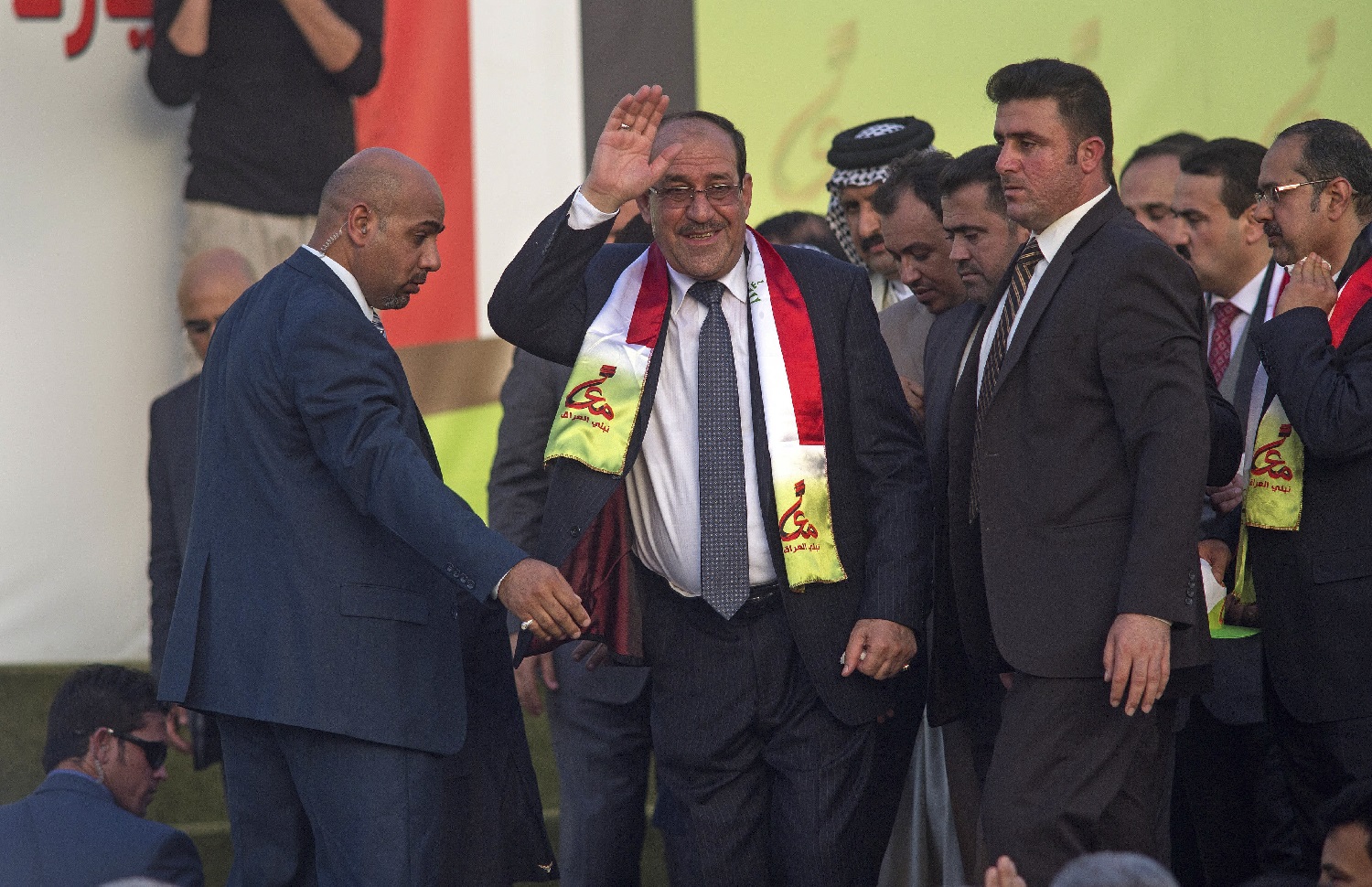
Nouri al Maliki at a rally in Baghdad before the April 30, 2014 parliamentary elections (Max Becherer/The New York Times)
Before the 2018 parliamentary election, Dawa split into two factions: The State of Law coalition, led by Maliki, was pro-Iran. Abadi led the Nasr coalition, which was more favorable to the United States. Maliki’s faction won 25 seats, and Abadi’s faction won 42 seats. Dawa lost its preeminent position for the first time in post-transition Iraq. Maliki’s faction backed the Bina bloc which was pro-Iran.
Ties with Iran: Iran backed Dawa throughout its political exile and its return to Iraq. Maliki lived in Iran for eight years during his exile from Iraq. As prime minister, he visited Tehran and maintained strong ties with the Revolutionary Guards. After Dawa failed to secure the plurality of votes in the 2010 elections, Soleimani brokered an agreement between senior Shiite and Kurdish politicians to keep Maliki in power. Maliki leaned on pro-Iranian militias such as Asaib Ahl al Haq to consolidate his grip on power.
Iran again played a critical role in shielding Maliki from a no-confidence motion in 2012 by intervening with both President Jalal Talabani, a veteran Kurdish politician, and the Sadrists, a pro-Iran militia and political movement, in parliament. But Tehran abandoned its support for Maliki after ISIS swept through Iraq in 2014. Despite Maliki’s diminished political stature, Iranian President Hassan Rouhani met with Maliki during his visit to Baghdad in May 2019.
Sairoon
Founded: 2018
Leaders:
• Muqtada al Sadr (spiritual leader)
• Hassan al Kouli (political leader)
Parliament (2018): 54 seats out of 329
Evolution: Iran backed the formation of the Mahdi Army, a militia led by Muqtada al Sadr, in the immediate aftermath of the 2003 U.S. invasion of Iraq. Drawing from Iraq’s poorer Shiite class, the Mahdi Army was initially among the deadliest militias that fought to expel U.S. forces. Sadr fled to Iran ahead of a push by coalition forces against his militia in 2007. By 2008, the Iraqi Army ousted the Mahdi Army from Basra, and Sadr ordered his militia to suspend operations.
In 2011, Sadr returned from his self-imposed exile and rebranded himself as an Iraqi nationalist. He distanced himself from Iran by denouncing Prime Minister Maliki, Iran’s ally, as a dictator and levying charges of corruption against Maliki and his ministers. Sadr, however, still maintained some ties with Iran. In 2014, Sadr formed the al Ahrar bloc to contest elections and prevent Maliki, Iran’s ally, from serving a third term. The bloc won 34 seats. After the election, Sadr again criticized Iranian political influence in Iraq; he also visited Saudi Arabia, Iran’s regional rival, to improve his relationship with Gulf states.
For Iraq’s 2018 parliamentary elections, Sadr opted against running with the pro-Iran Fatah alliance. He instead allied with Iraq’s liberal and communist parties to form Sairoon, or the Forward party. Sairoon placed first in the 2018 parliamentary elections with 54 seats but did not win enough seats to select the next prime minister. Iran’s political influence was still so pervasive that Sairoon ended up having to negotiate with Iran’s allies in Fatah. They agreed on compromise candidate Adel Abdel Mahdi after five months of negotiations.
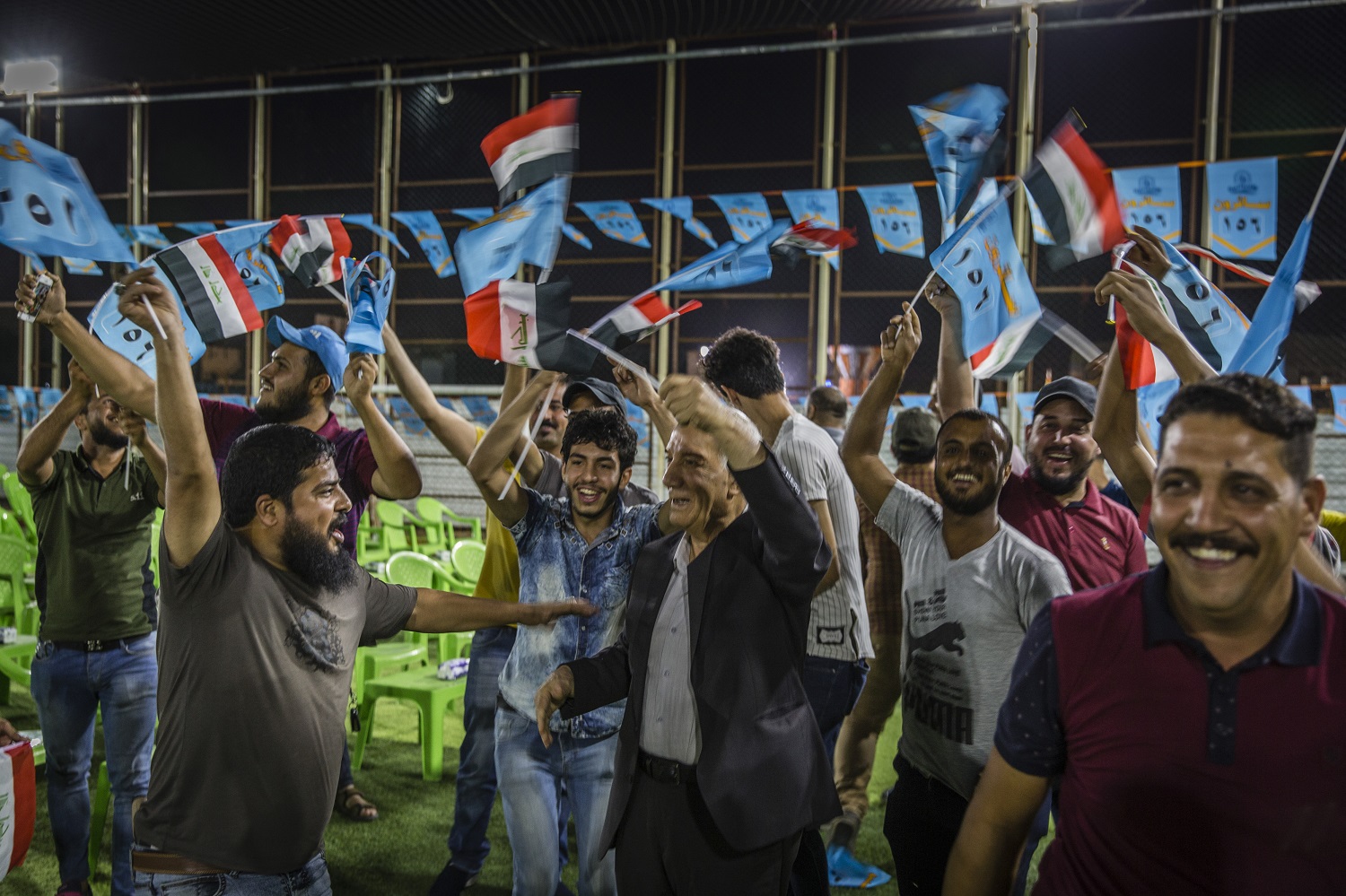
Sairoon rally ahead of parliamentary elections in Baghdad, May 9, 2018 (Ivor Prickett/The New York Times)
Ties with Iran: The IRGC provided the Mahdi Army with explosively propelled penetrators (EFPs), a special type of improvised explosive devices (IEDs) designed to penetrate the armor of U.S. armored vehicles. In 2007, Abu Mahdi al Muhandis, then an Iraqi advisor to Soleimani, sent Mahdi Army fighters to Iran for training in guerilla warfare, light arms, marksmanship, IEDs, and anti-aircraft missiles.
But Iran has not always been able to depend on Sadr as a political ally. By 2016, Tehran had cut off much of its support for the group. Sadr, however, has shown a willingness to work with Iran on issues of mutual interest. Iran has kept up its personal ties with Sadr who has frequently visited the holy city of Qom. Sadr made a surprise visit to Tehran in September 2019 during the Shiite holy day of Ashura. He appeared in a video at religious services sitting beside Supreme Leader Khamenei and Qods Force Commander Soleimani.
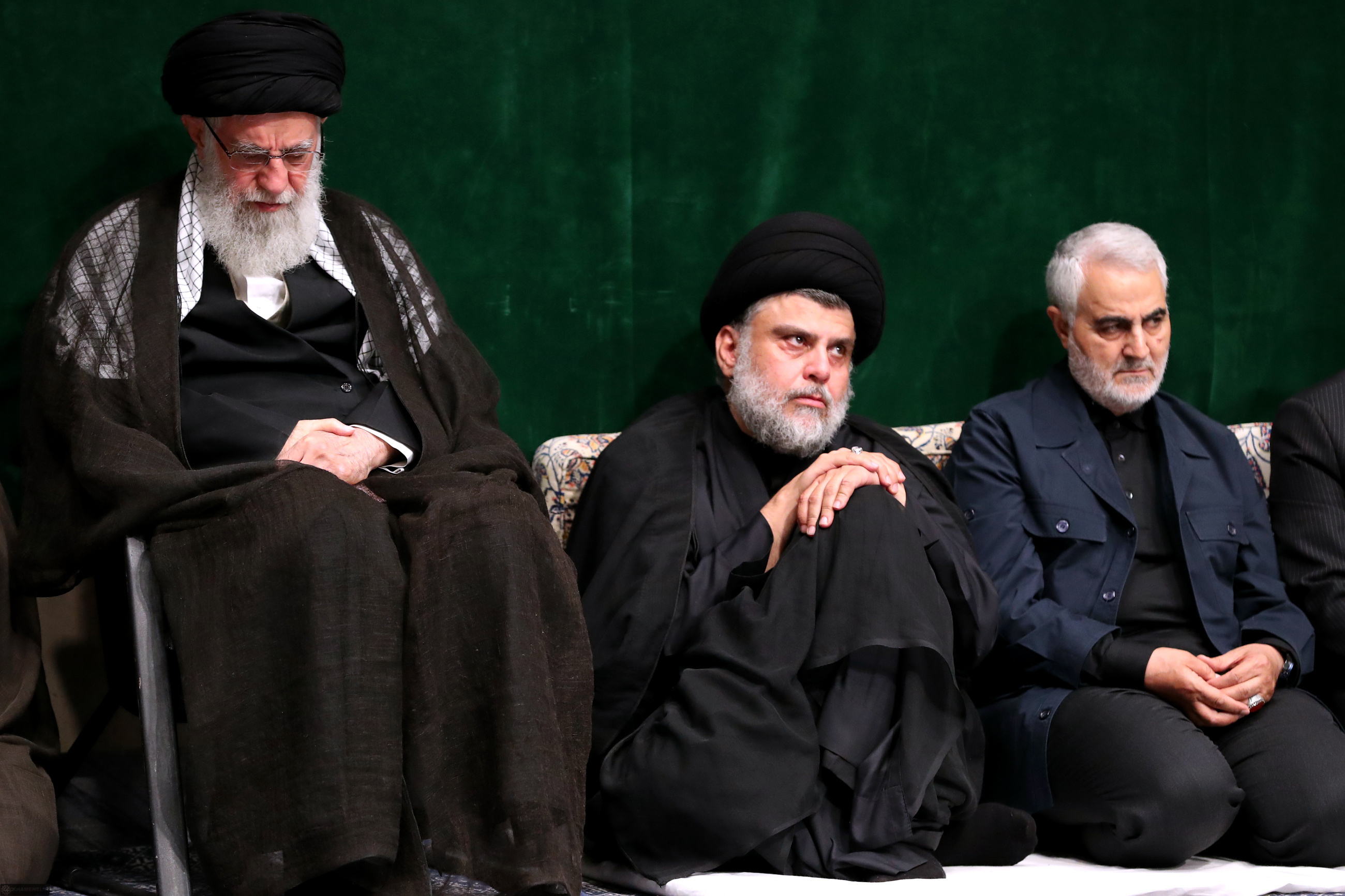
Supreme Leader Ayatollah Ali Khamenei, Muqtada al Sadr and Qods Force Commander Qassem Soleimani in Tehran in September 2019 (Khamenei.ir)
Sadr traveled to Iran again in November 2019 amid protests in Baghdad against Iranian influence in Iraq. In January 2020, he met with the leaders of Iraqi Shiite militias in Qom, Iran to discuss ways to expel U.S. troops from Iraq.
#Iraq’s Shia cleric, leader of Sairoon political bloc, Muqtada al-Sadr, met leaders of mostly #Iran-backed armed groups within Hashd al-Shaabi (PMF) in Qom, Iran. Discussion inc ways to expel foreign troops in Iraq, acc to Nasr al-Shimmari (right of Sadr) from al-Nujabaa group. pic.twitter.com/VpIptVwKtI
— Arwa Ibrahim (@arwaib) January 13, 2020
Palestinian Territories
Hamas
Founded: 1987
Leaders:
• Chairman Ismail Haniyeh
• Head of the political office in Gaza Yahya Sinwar
Parliament (2006): 74 seats out of 132
Other positions in government: A Hamas-dominated government has ruled in Gaza since 2007. A government led by the PLO runs the government in the West Bank. The Palestinian Legislative Council—of elected representatives from both Gaza and the West Bank—has not met since 2006.
Evolution: Iran’s support for Hamas dates back to the early 1990s. Hamas – the Islamic Resistance Movement or Harakat al Muqawama al Islamiyah – began as the Gazan branch of the Egyptian Muslim Brotherhood. It spun off from its mother organization in 1987 during the first intifada and founded a military wing, the Izzedine al Qassam Brigades, in 1991. By then, Iran was already providing substantial financial assistance to the organization. In 1992, Palestinian Liberation Organization (PLO) Chairman Yasser Arafat claimed Iran had provided a total of $30 million to Hamas.
Hamas first chose to participate in the 2006 legislative elections; it won 76 out of 132 seats, an outright majority. Iran gave Hamas an extra $120 million after the new government took office, while the United States and European Union cut hundreds of millions in aid to the Hamas-led government.
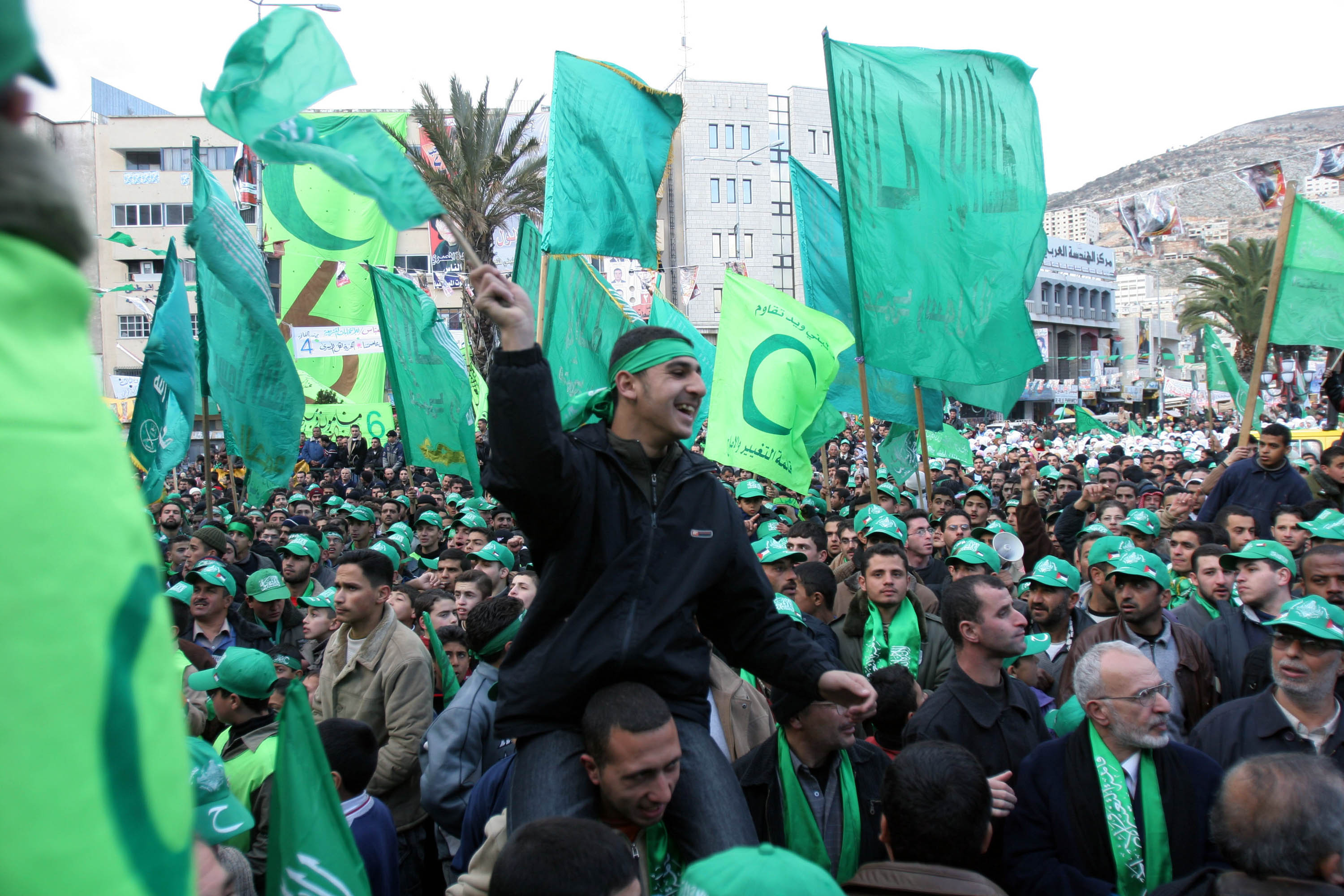
A Hamas celebration in Nablus after the 2006 legislative elections (Rina Castelnuovo/The New York Times)
In 2007, Hamas seized control of Gaza, while the PLO retained control over the West Bank. Since the Hamas takeover, Israel and Egypt have maintained a blockade on Gaza that has caused an economic crisis. Iran has remained an important source of financial and military support to the isolated territory. Efforts to form a Palestinian unity government have repeatedly failed, and no elections have been held in the Palestinian Territories since 2006.
Ties with Iran: Iran’s support for Hamas enhances its revolutionary credentials among Arabs and the wider Muslim world on the Palestinian issue. Iran’s goal is to be the vanguard of the Islamic world, including supporting Sunni groups. Supporting the Palestinian cause is one way that Iran seeks to transcend the Sunni-Shiite divide.
For more than three decades, Iran has provided financial support to Hamas; it ranged from $20 million to $50 million annually from 1990 to 2000. In December 2006, Haniyeh visited Tehran, which pledged $250 million to support the Hamas-led government. He received tens of million dollars.
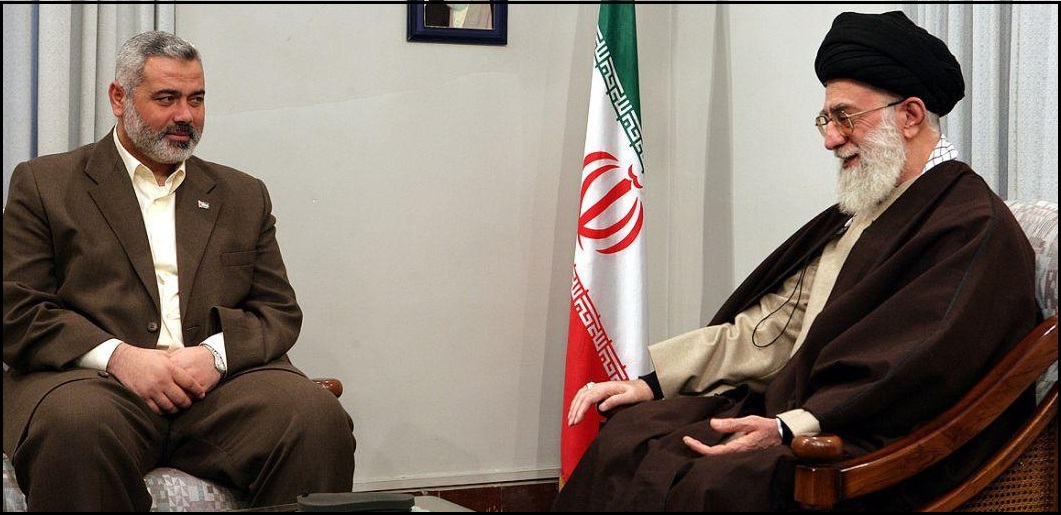
Ismail Haniyeh with Supreme Leader Ayatollah Ali Khamenei in Tehran in 2006 (Khamenei.ir)
In 2008, Iran upped its financial support of Hamas and increased the flow of weapons to Gaza. Iran reportedly produced or supplied many of the rockets fired by Hamas during the 2008 Gaza War with Israel. The conflicted ended when Israel unilaterally ceased fire in January 2009. The following month, Hamas’ political leader Khaled Mashaal visited Tehran. “You are our partners in the victory in Gaza,” he told the Iranian people in a speech. Mashaal also expressed gratitude to Iran’s supreme leader and president. “Thank you for all the financial, political and popular support which you have given to us. The Palestinian people will not forget.”
Iran’s relationship with Hamas frayed at the outbreak of the Syrian civil war in 2011. Hamas backed the Syrian opposition and Iran backed the Assad regime. In 2012, Iran cut off funding to Hamas. In 2017, Hamas leaders chose a new chief, Yahya Sinwar, to head the organization in Gaza. Sinwar preferred Iran as a patron over Sunni Gulf states. Iran and Hamas reconciled later in 2017, and Tehran resumed its funding. “Relations with Iran are excellent and Iran is the largest supporter of the Izzedine al Qassam Brigades with money and arms,” Hamas chief Yahya Sinwar said in August 2017. “The relationship today is developing and returning to what it was in the old days … This will be reflected in the resistance [against Israel].” In August 2019, Iran reportedly pledged to increase funding to $30 million per month in exchange for information about Israel’s missile stockpiles.
Political Movements in the Gulf
In the early years after the 1979 Islamic Revolution, Iran tried to export its ideology to other Muslim majority countries, including the Gulf sheikhdoms. In 1982, Tehran hosted a seminar attended by clerics and militants from more than a dozen countries committed to a worldwide Islamic revolution. The Islamic Republic backed underground political movements in the Gulf, but it failed to gain as much traction as it did in Lebanon and Iraq. Iran’s regional agenda was also diverted after Iraq’s invasion in 1980; their war, the deadliest in modern Middle East history, did not end until 1988.
Bahrain
For decades, Iran’s most robust Gulf political network has been in Bahrain, where Iran has voiced its support for several Shiite dissident groups. The small country off the coast of Saudi Arabia is ruled by a Sunni monarchy, but its population is majority Shiite. A minority of Bahraini Shiites are ethnic Persians known as Ajam.
In the 1980s, Iran sent Shiite clerics to preach revolution in Bahrain. In 1981, Tehran backed a failed coup attempt against the monarchy by the Islamic Front for the Liberation of Bahrain, a revolutionary Shiite group. Iran provided military training, fake police uniforms, and favorable media coverage of the effort. In the 1990s, Iran backed Hezbollah al Hejaz, a spinoff of Lebanese Hezbollah that operated in Bahrain. At Iran’s direction, the group smuggled weapons into Bahrain and joined civil disobedience protests.
Since the 2000s, Iran has favored a more indirect approach to Bahrain that supported Shiite opposition groups and amplified their grievances in the Iran’s Arab-language media. In 2010, al Wefaq, the only Shiite political party in Bahrain, won 18 out of 40 seats on the Council of Representatives. During demonstrations in 2011, Bahrain’s ambassador to the U.S. accused al Wefaq of “carrying the agenda of Iran.” Wefaq’s former senior leader, Sheikh al Salman denied the group had received backing from Tehran. “We have no connection with Iran,” he told the BBC in February 2012. “We are not calling for the overthrow of the royal family. We want reform.”
Iranian media promoted the more radical elements of the protest movement – the Haq Movement and the Bahrain Freedom Movement – that called for abolition of the monarchy. In December 2014, Bahrain arrested al Wefaq’s leader for “inciting hatred against the regime” and cracked down on the Shiite political opposition. In 2016, a Bahraini court dissolved al Wefaq, pushing the country’s Shiite political opposition entirely underground. Since then, Shiite militants have launched multiple armed attacks on security forces. In March 2017, Bahrain said it uncovered an Iranian-linked militant group involved in arms smuggling and military training of radical groups. In October 2017, a bomb attack on a police bus killed one officer and wounded nine others. Bahrain blamed a cell allegedly connected to the IRGC.
Kuwait
Iran has meddled in the internal affairs of Kuwait. Iran has an interest in the Gulf sheikhdom because a third of its population of 4.5 million is Shiite; the majority are of Persian descent. The Kuwaiti government has accused Iran and Hezbollah of backing violent Kuwaiti militants. In 1980, Kuwait expelled a prominent sheikh and 18 of his followers for publicly supporting Iran’s revolutionary leader Ayatollah Ruhollah Khomeini. It also revoked their citizenship. Kuwait sided with Iraq during its 1980-1988 war with Iran; its tankers ferried Iraqi oil for export.
In 1983, operatives of two Iranian proxies—Lebanese Hezbollah and Iraqi Dawa—carried out coordinated bombings in Kuwait on the U.S. and French embassies, the airport, a power plant, a national petrochemical plant and a Raytheon facility. In 1985, Iran and its proxies were implicated in an assassination attempt on the Kuwaiti emir by Shiite fundamentalists. Between 1985 and 1987, some 50 Shiites with alleged ties to Iran were arrested on charges of sabotage and terrorism.
The 1990s and 2000s saw a lull in Iranian meddling that coincided with improved bilateral relations. But in the late 2010s, Iran appeared to revive its support for anti-government militants within Kuwait. In 2015, Kuwaiti security forces discovered a weapons cache, which they linked to an Iranian-backed militant cell. In January 2016, Kuwait sentenced two defendants to death, including one Iranian, on charges of spying for Iran and for supporting the militant cell. In 2017, the Kuwaiti government arrested 12 individuals it had alleged were part of the cell and expelled 15 Iranian diplomats from the country. In total, Kuwait charged 25 of its nationals of being involved with the militant cell, all Shiite.
Iran and Kuwait have maintained diplomatic relations despite Tehran’s meddling and regional tensions between the Arab sheikhdoms and the Islamic Republic. Kuwait did not shutter its embassy in Tehran after Saudi Arabia severed diplomatic ties with Iran in January 2016. In February 2017, President Hassan Rouhani visited Kuwait to discuss prospects for diplomacy between Iran and the Gulf Cooperation Council -GCC talks. In November 2019, Kuwait offered to mediate high level direct talks between Iran and Saudi Arabia.
Andrew Hanna is a research assistant at the U.S. Institute of Peace. Garrett Nada is the managing editor of The Iran Primer.
